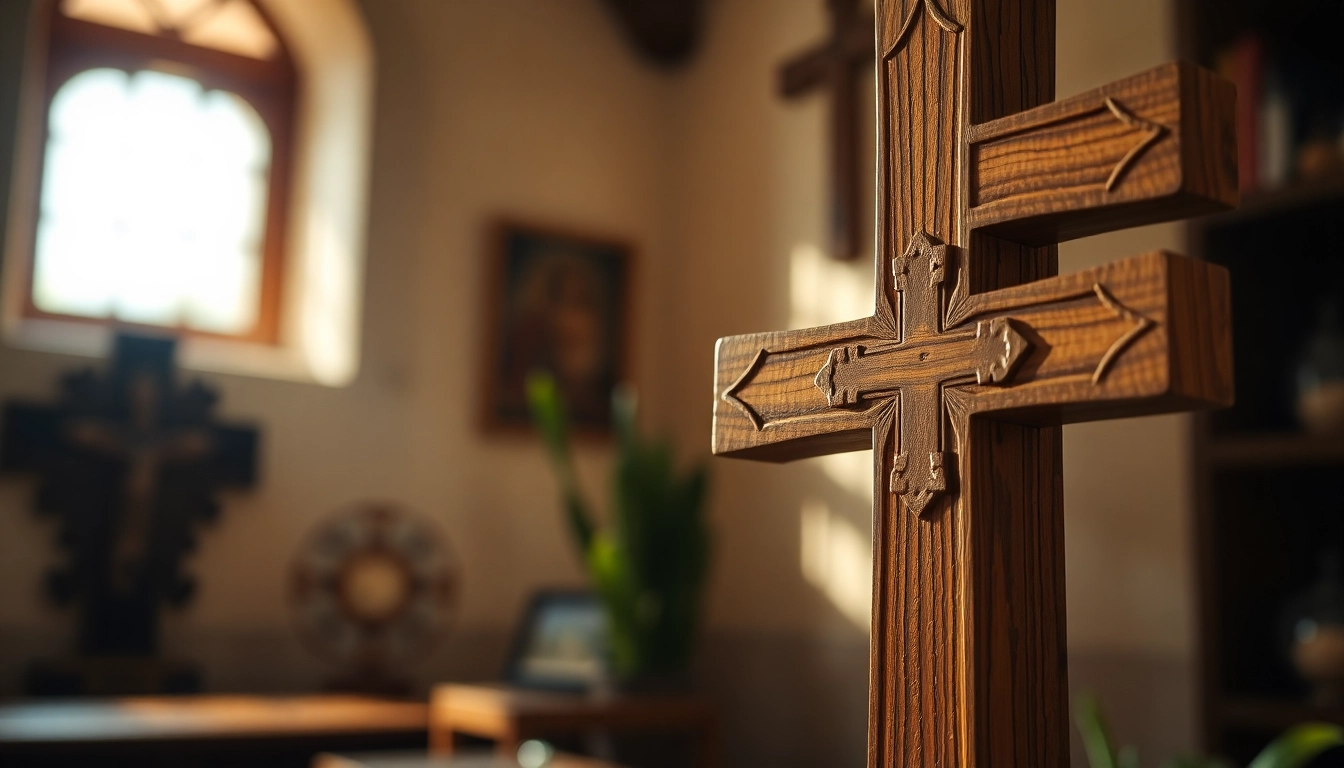The History of Jerusalem Crosses
Origins and Symbolism
The Jerusalem cross, often referred to as the five-fold cross or Crusader’s cross, has a rich history deeply rooted in the Christian faith. This heraldic and Christian cross variant prominently features a large cross potent (an upright cross with expanded ends) at its center, surrounded by four smaller Greek crosses, each located in one of the quadrants. These smaller crosses symbolize the Four Evangelists: Matthew, Mark, Luke, and John, as well as the message of Christ’s teachings spreading to the four corners of the earth. Historically, the cross has been associated with the Kingdom of Jerusalem, established in 1099 after the First Crusade. Its design has shifted over time but continues to reflect themes of faith, triumph, and spirituality.
Craftsmanship Through the Ages
From the Crusader era to the present day, the craftsmanship of Jerusalem crosses has evolved significantly. Artisans have crafted these crosses using various materials, including wood, gold, silver, and jewelry stones, reflecting their dedication to quality and symbolism. Traditional wooden crosses are often handmade from olive wood sourced from trees in the Holy Land, emphasizing their connection to the region and its religious significance. The crafting techniques vary among different artisans, resulting in unique designs that maintain the iconic structure of the Jerusalem cross while infusing personal artistry.
The Role of Jerusalem Crosses in Christianity
Jerusalem crosses serve as a potent symbol of faith for Christians around the world. They represent not only the historical significance of the Christian faith in Jerusalem but also the commitment to spreading the message of Christ. Many Christians wear these crosses as a testament to their beliefs. Additionally, the crosses often find their place in religious ceremonies and are utilized in places of worship, further emphasizing their importance in both personal and communal expressions of faith.
Different Variations of Jerusalem Crosses
Traditional Designs and Their Meanings
While the standard form of the Jerusalem cross remains prevalent, various traditional designs exist, each carrying unique meanings. Some crosses are adorned with additional ornaments, such as inscriptions or decorative elements that reflect specific local traditions or historical ties. For example, in some Eastern Christian communities, the Jerusalem cross may incorporate additional symbols representing specific saints or events in Christian history, enhancing its richness and appeal.
Modern Interpretations and Styles
In recent years, modern interpretations of the Jerusalem cross have emerged, with artists combining contemporary styles with traditional imagery. These variations may adopt sleek designs, incorporate mixed materials, or focus on minimalist aesthetics while retaining the essential message behind the cross. This mix of tradition and modernity allows for a broader appeal, making the Jerusalem cross accessible to new generations of believers and collectors alike.
Regional Differences in Jerusalem Crosses
Jerusalem crosses are not homogenous; they possess distinct regional characteristics that highlight local culture and craftsmanship. For instance, crosses crafted in Bethlehem may utilize different wood types or carving styles compared to those made in other parts of the Holy Land or abroad. These variances offer insights into the cultural context of each region, making each piece not just an object of devotion but also a collectible artifact representative of its heritage.
Buying and Caring for Jerusalem Crosses
Tips for Choosing the Right Jerusalem Cross
When selecting a Jerusalem cross, consider both personal significance and the craftsmanship involved. Look for pieces that resonate with your personal faith journey, whether you prefer a traditional wooden cross or a modern silver iteration. Ensure that the materials used are authentic and derived from reputable artisans who respect traditional practices. The Jerusalem crosses available at specialized shops often come with insights into the production process and historical context, enhancing the overall value of the piece.
Care and Maintenance of Wooden Crosses
Particularly for wooden Jerusalem crosses, proper care is essential for maintaining their beauty and integrity. To prevent fading and cracking, keep these crosses out of direct sunlight and away from extreme humidity. Regularly dusting with a soft cloth will help preserve the wood’s finish, while occasional applications of wood conditioner can restore luster. For crosses featuring additional decorative elements, consult with the artisan or a conservation expert on appropriate maintenance methods.
Where to Purchase Quality Jerusalem Crosses
Quality Jerusalem crosses can be purchased from various sources, including local gift shops in the Holy Land, online retailers specializing in religious artifacts, or local Christian boutiques. It’s advisable to research the seller’s credentials and confirm that their products adhere to ethical sourcing practices. Authenticity guarantees and historical context can often enhance the buying experience, ensuring that collectors and believers alike are investing in meaningful pieces.
The Spiritual Significance of Jerusalem Crosses
Symbolism in Christian Faith
In the context of Christian faith, the Jerusalem cross carries profound symbolism. It serves as a reminder of sacrifice, redemption, and the global mission of Christianity. Believers often reflect on its design during personal contemplation, seeing it not just as an emblem, but as a focal point for prayer and connection to the divine. The cross symbolizes a commitment to spreading the teachings of Christ and walking in His footsteps, capturing the essence of the Gospel message.
Jerusalem Cross in Prayer and Worship
The presence of the Jerusalem cross in prayer and worship settings adds a visual anchor for congregants. Churches may utilize the cross as a focal point during services or religious gatherings, incorporating its imagery into liturgical practices. Devotional practices may also involve wearing the cross, placing it in prayer spaces, or using it during significant rites such as baptisms, weddings, or memorials, amplifying its role as a sacred symbol.
Personal Meaning of the Jerusalem Cross for Believers
For many believers, the Jerusalem cross serves as a personal symbol of faith, hope, and perseverance. It is common for individuals to carry small versions of the cross or wear it as jewelry, making it a continual reminder of their spiritual journey. The personal meanings attached to the cross can vary widely, encompassing aspects of one’s life, struggles, aspirations, and dedication to a faith-filled life.
Popular Misconceptions About Jerusalem Crosses
Addressing Controversies
Despite its widespread acceptance, the Jerusalem cross is not without controversy. Some misconceptions arise from its historical ties to the Crusades, with some seeing it as a symbol of religious conflict and exclusion rather than unity and peace. Addressing these misconceptions involves understanding the historical context behind the cross and promoting dialogues that emphasize its core message of love, compassion, and fellowship.
Understanding Cultural Perspectives
Throughout history, the Jerusalem cross has appeared in a variety of cultures, each interpreting its significance based on local beliefs and customs. Engaging with these cultural perspectives fosters a more inclusive understanding of what the Jerusalem cross represents across different societies. Recognizing its multilayered significance can aid in reshaping dialogues and perceptions regarding its role in both historical and contemporary settings.
Jerusalem Crosses Beyond Religious Symbols
Jerusalem crosses have transcended their purely religious symbolism, being embraced in various artistic and cultural contexts. Artists have incorporated the cross’s imagery into modern art, fashion, and home decor, showcasing its aesthetic appeal and universality. This diversity of representation invites broader interpretations that extend beyond the confines of faith, promoting a message of hope and unity across different belief systems.



